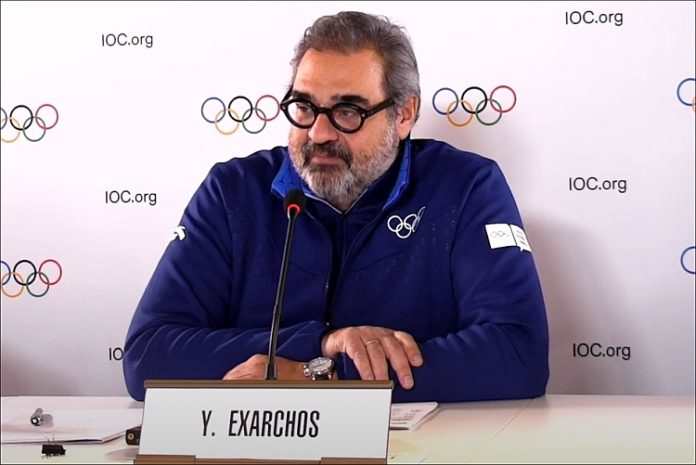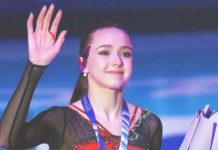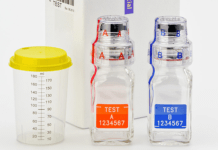
★ The Sports Examiner: Chronicling the key competitive, economic and political forces shaping elite sport and the Olympic Movement.★
★ To get The Sports Examiner by e-mail: sign up here! ★
★ Friends: The bill is in for technical support costs. Donors have already picked up 30% of the total, but we need your help. Please consider a donation to help keep this site going. Thank you. ★
≡ THE 5-RING CIRCUS ≡
1. Cloud computing, artificial intel changing Olympic broadcasting
2. WADA concerned over youth doping and reactions
3. USA Basketball announces 41 in men’s Olympic player pool
4. ROC chief: path back for Russia is through Asia
5. Sailing allows Russian, Belarus for Last Chance Qualifier
● Olympic Broadcasting Services chief Yiannis Exarchos explained the changes coming to broadcasting at the Paris Games, some of which are being tried at the ongoing Winter Youth Olympic Games in Korea. Technologies already in use are cutting the number of people required and could offer federations spectacular new options to show their own events.
● The World Anti-Doping Agency published a report on doping and youth, noting that while the number of positives is not large, the impact on youngsters of a positive test can be very hurtful. From 2012-23, there were 1,518 positive tests from 1,416 athletes, with the largest number of positives in athletes from Russia, India and China.
● A spectacular roster of 41 star NBA players was named by USA Basketball as candidates for the 2024 men’s Olympic Team. The list include 13 Olympians, all 12 members of the U.S. World Cup team from 2023 and 25 NBA All-Stars. Only 12 will make the team. Wow.
● The head of the Russian Olympic Committee praised a youth competition in eastern Russia, and said the future of Russia’s re-entry into international competitions will go through Asia, and via youth events to begin with.
● World Sailing, following the directions of the IOC, agreed to allow Russian and Belarusian entries – subject to as-yet unpublished “neutrality” criteria – at the final Olympic qualifier, and if qualified, at the Paris Games. But nowhere else.
● Panorama: Alpine Skiing (Strasser wins second straight World Cup Slalom) = Athletics (3: Lasitskene can’t believe she’s out of Paris; USATF Foundation to pay $100,000 to hammer throwers; Mexico’s Gonzalez gets another four-year doping ban) = Cricket (no protest for second South Africa match at U-19 World Cup) = Figure Skating (Russian team doctor wins defamation suit in Moscow vs. Germany’s ARD) = Football (2: four more Udinese fans sanctioned for racist chants; match in Cyprus called off for fans throwing flares on the field) = Sailing (World Sailing to allow Russians, Belarusians in last-chance qualifier) = Surfing (8x World Champion Stephanie Gilmore takes a year off) ●
1.
Cloud computing, artificial intel changing Olympic broadcasting
A fascinating – and somewhat scary – look into the future of Olympic broadcasting was shared at an online round-table session with Olympic Broadcasting Services chief Yiannis Exarchos (GRE) from the Winter Youth Olympic Games in the Gangwon Province of Korea on Wednesday.
Exarchos, the head of OBS since 2012, explained that a revolution in television production is underway, with more and more broadcasters adopting the “Olympic Cloud” technology used in Tokyo in 2021 (via Olympic sponsor Alibaba) to allow them to create their Olympic broadcasts at home instead of having to bring hundreds of staff to the site of the Games. They are being employed now:
“Many traditional fundamentals that we would have in the host city like the master control of the Games, distribution to broadcasters, creating graphics, creating and editing stories and so on, all these are not done in Gangwon. They are done back in the headquarters of OBS, in Madrid, where we have our technical facilities.
“This obviously leads into very significant savings, and also very significant help for the local organizers. We have less people on the ground, they need less support, less logistics, less transport, less accommodation, and this is the way to the future.”
Exarchos said 44.5% of the OBS production effort is remote in Gangwon, and that requests for remote distribution for Paris from right-holding broadcasters is up 279% from Tokyo in 2021. Moreover, the use of cloud technology for Games broadcasting is allowing a smaller footprint in the venues, replacing the familiar production van with servers and distribution links through cloud computing.
Already, systems of this type are proving themselves in Gangwon for curling and ice hockey. The same concept will be used in Paris for judo, shooting, tennis and wrestling. Exarchos: “It’s far more efficient and far more sustainable.”
The OBS chief also explained at length the impact of artificial intelligence (A.I.) on the broadcast process, already a major part of the OBS plan for Paris. He pointed to the 11,000 hours of content that OBS will produce in Paris:
“It’s a huge amount of content, and obviously to manage and create highlights out of it, customized highlights for different countries, different athletes, different sports, for different platforms, for social media for vertical videos and so on, this does require a huge capacity.
“And A.I. has started very credibly producing this capacity for us. So this scaling is giving us and our rights-holding broadcasters a lot of capacity and a lot of capabilities. …
“We will be using automated highlights for 14 different sports in Paris. … The difficulty for us is to create credible systems for many sports that are not, let’s say, so popular.”
A.I.-generated highlights will be created in Paris for athletics, badminton, basketball, beach volleyball, football, artistic gymnastics, handball, skateboarding, swimming, table tennis, tennis, volleyball and wrestling.
He also discussed a fascinating project, to use A.I. for live production, using a multi-lens concept:
“This technology is not yet mature for the complexity that we have in the Olympic Games but I think that in a very short period of time, it will be quite mature for lower-level coverage, for simpler coverage, and will be extremely cost effective, and also very, very sustainable.
“So we will keep on testing these systems and see how we can actually use them at some point in the Games.”
This is an exciting concept, especially for smaller sports federations, to be able to better offer streaming coverage of their own events, on their own sites and others.
But Exarchos was also concerned about the danger side of A.I.:
“Risks around the protection of private identity and the privacy, risks around the protection of minors, risks around the protection of [intellectual property], risks around the protection of what is real and what is fake. I belong to the ones who believe that very, very fast the world should start reacting and putting a structure of regulation around several elements of A.I. and for us, all these things are a consideration.”
The IOC’s head of digital, Leandro Larrosa (ARG), noted that these technologies are allowing the IOC to feed its social-media channels – 40 of them, in nine languages – faster than ever. The organization’s total social audience grew from 90 million in 2022 to 115 million in 2023, despite not having an Olympic Games in that year.
Observed: Although Exarchos noted it, the impact of the cloud-computing elements on Olympic television production will have an enormous impact on the future staging of the Olympic Games. The substantially-reduced need for space, people, hotel rooms, food, transportation and everything else will reduce organizing committee costs significantly and make available resources for officials, media, sponsors and, yes, even fans, more abundant and at lower cost.
And as he signaled, while there are dangers, these technologies will only accelerate in the future.
2.
WADA concerned over youth doping and reactions
The World Anti-Doping Agency circulated a 29-page report showing concern over the impacts of a positive doping test on younger athletes, especially minors.
Prompted in 2021 by increasing reports of doping among minors, the WADA Intelligence & Investigations Department began a survey of the issue to find possible patterns and remedies. What they found was that while doping was hardly widespread, it could be devastating, especially in seven key areas:
● Trauma: “One of the major themes to emerge from the interviews was the deep trauma felt by Minors following a Positive Test and sanction. The Minors described the trauma they or a loved one felt when being removed from their sport and rejected by friends or family members, and how this rejection led to a significant psychological impact.”
● Isolation: “Another theme to emerge was a sense of isolation, which is not surprising given many had been part of a sports community for the better part of their childhood. The separation from their sporting community took such a toll that many exhibited signs of depression (e.g., difficulty getting out of bed, conducting normal activities, attending school).”
● Impact: “The interview of family members provided a unique perspective and highlighted the frustration and trauma felt by those within the Minor’s closest support network. Parents and siblings expressed a feeling of being victimized by rumors and innuendo regarding their alleged complicity in the violation. Some had been accused by other parents of being implicated in their child’s Positive Test, and this led to a sense of betrayal and further isolation. In one instance the impact was so significant that a parent considered removing their youngest child from the sport for fear that they would be stigmatized for being the sibling of a Minor who had tested positive.”
● Pressure to Succeed: “All Minors that were interviewed spoke about the immense pressure of competition and how this pressure impacted them before, during, and after their sanction. The pressure to continuously achieve better results also directly and indirectly influenced the decision of some to use banned substances or methods.”
● Pressure from Coaches: “One disturbing account came from a female Minor who recalled the extreme pressure she and other female athletes felt from the male coaches to keep their weight down. This pressure included an impossible expectation to slow down the effects of puberty because puberty would supposedly negatively impact their ability to compete.”
● Ignorance: “The lack of anti-doping knowledge and education was another theme present in the interviews. One Minor described being unaware that a recovery method they had been prescribed was a Prohibited Method. Consequently, when the Minor was notified of their doping violation, the shock triggered a mental health condition which left them scrambling and unable to mount a proper defense to the violation.”
● Abandonment: “A telling aspect from the interviews was the sense of abandonment felt by Minors following the Positive Test and eventual sanction. Some felt forgotten and were disappointed by the lack of communication and support they claimed to have received from their [anti-doping organizations].”
The study – “Operation Refuge” – collected data over 10 years and found that in-competition testing accounted for 60% of all tests, and the most tests being taken in China, Russia, France, South Korea, Germany, and Kazakhstan. The youngest subject was eight years old.
From 2012-23, there were 1,518 positive tests from 1,416 athletes. No data on the total number tested was given, but the study noted that “Minors produce a slightly less percentage of Positive Tests than the general population of other athletes.” For comparison, WADA’s 2020 doping violations report showed by sports group:
● Summer Olympic: 114,840 samples, 592 positives (0.005%), 418 violations
● Winter Olympic: 13,817 tests, 31 positives (0.002%), 19 violations
So, while the numbers are low, the individual impact can be quite high.
The most common prohibited drugs found in the tests were Furosemide (a diuretic), the stimulant Methylphenidate, and an anabolic steroid, Metandienone. The sports most impacted were weightlifting, athletics and aquatics, and the countries with the largest number of positives were Russia, India and China (no statistics provided).
The report notes that the best immediate solution is more education, but called for a “better, more unified coordination is required within the anti-doping community to improve the experience and protection of Minors within the anti-doping process.”
3.
USA Basketball announces 41 in men’s Olympic player pool
An enormous list of 41 players was announced by USA Basketball as candidates for the American Olympic Team this summer in Paris, which will include just 12 men.
USAB Men’s National Team Managing Director Grant Hill headed the selection process for the long list of star players, which includes 25 NBA All-Stars, 22 FIBA World Cup participants and 13 Olympians:
● Bam Adebayo (2020)
● Devin Booker (2020)
● Jimmy Butler (2016)
● Anthony Davis (2012)
● Kevin Durant (2012-16-20)
● Paul George (2016)
● James Harden (2012)
● Jrue Holiday (2016)
● Kyrie Irving (2016)
● LeBron James (2004-08-12)
● Damian Lillard (2020)
● Chris Paul (2008-12)
● Jayson Tatum (2020)
The player pool also includes standouts such as Steph Curry, Joel Embiid, Kawhi Leonard, Donovan Mitchell, Trae Young and others who have not been on a U.S. Olympic Team yet. All 12 members of the 2023 FIBA World Cup team, which placed fourth, are on the list.
In a complete understatement, Hill noted:
“Assuming everyone stays healthy and everyone’s interest level continues as it is, we have a chance to have a very special group, a team that has a lot of star power, but also a team that just has a lot of balance, a lot of versatility and will give us an opportunity of winning a gold medal in Paris.”
One player not on the roster is two-time Olympic gold winner Draymond Green, who has been suspended for violence twice already during the NBA season. Hill told The Associated Press:
“We all understand and certainly have great respect and sensitivity to this particular period in his career and he’s working through some things both on and off the court.
“We at USA Basketball, we want to support him on his journey. We just didn’t feel that playing over the summer gives him the best opportunity to do what he needs to do.”
The team will be coached by Warriors head coach Steve Kerr, assisted by Mark Few (Gonzaga), Ty Lue (Clippers) and and Erik Spoelstra (Heat). Three exhibition games are on the schedule prior to Paris, on 10 July vs. Canada (in Las Vegas); 20 July vs. South Sudan (London) and vs. 2023 World Cup champs Germany on 22 July, also in London.
The American men will be trying for their fifth Olympic gold in a row and have an all-time Olympic record of 143-6.
4.
ROC chief: path back for Russia is through Asia
The Primosky Territory is at the far eastern end of Russia, opposite the northern Japanese islands, and according to Russian Olympic Committee chief Stanislav Pozdnyakov, will be the entry point for the return of Russian athletes to international competition:
“The projects that the Primorsky Territory is implementing are iconic, significant sporting events. The Children of Asia Games were a great success, they became the standard for holding this kind of international sporting events. Today we are at the finish line of the Children of Primorye project which will connect the closest countries in the Far East. The path for the return of Russian sports to the international arena lies through these countries, through Asia.
“The return of Russian sports will take place through children’s and youth sports. And this project fully corresponds to these tasks. This is the basis of the future Olympic Movement.”
Pozdnyakov spoke Wednesday at a presentation on the Children of Primorye program. The inaugural “Children of Primorye” winter-sports event will be held from 18-23 February, with athletes from Russia, Belarus, North Korea, China and some others.
Pozdnyakov also criticized the International Olympic Committee for its promise to independently check the “neutrality” credentials of athletes who could compete at the 2024 Paris Olympic Games, saying “This shows the level of mistrust in the international sports federations, which allowed our athletes in a neutral status.”
No kidding.
5.
Sailing allows Russian, Belarus for Last Chance Qualifier
World Sailing announced Wednesday that “Those who meet the necessary eligibility criteria will be permitted to participate as AINs in competition for the Paris 2024 Olympic Games, starting with the Last Chance Regatta qualifying event, to be held as part of the Semaine Olympique Francaise, 20-27 April, and finishing with the Olympic regatta in Marseille.”
No participation in any other events will be allowed, and Russian and Belarusian sailors who wish to compete must apply to World Sailing for approval, with the specific process still to be provided.
The announced policy follows the IOC’s recommendations, and the continuing ban on all other competitions for Russians and Belarusians will be re-examined at quarterly intervals, with the next review by the World Sailing Council on 22 February.
If any Russian or Belarusian sailors do manage to qualify for Paris, they will be subject to the IOC’s own review for “neutrality.”
≡ PANORAMA ≡
● Alpine Skiing ● From 2014 to 2022, German Slalom specialist Linus Strasser won three World Cup races. He’s now won two in four days after his gold-medal performance at the FIS World Cup Slalom at Schladming (AUT)!
It was a rainy Wednesday on the slopes and 19 of the 73 starters failed to both the two-race set, but Strasser was in front after the first run at 50.46, trailed by Timon Haugen (NOR: 50.56). On the second run, France’s Clement Noel took the overall lead from the third-to-last position, with a combined total of 1:46.22.
But Haugen was faster yet at 1:45.48 and then Strasser capped his best week ever with a seventh-place second run that sealed a 1:45.20 win. It was Haugen’s third career individual World Cup medal, all of which have been silvers!
Now second in the seasonal World Cup Slalom standings, Strasser said afterwards, “I keep the momentum up and try to continue, but first of all, I’m going to celebrate tonight.”
● Athletics ● Tokyo Olympic champ and three-time World Champion in the women’s high jump, Russian Mariya Lasitskene has been clear about the emotional impact of the war sanctions that have kept her sidelined since Tokyo:
“It’s impossible to come to terms with this, I still can’t understand my condition regarding the Olympic Games.
“I’m a sober person and I understand the impossibility of my trip to Paris this year. But I didn’t let go of this situation, no matter how stupid it looks. I have disbelief that this could happen, although we already went through this [ban on competing] in 2016 at the Olympics in Rio de Janeiro.”
She won a meet in Moscow on Tuesday at a modest 1.90 m (6-2 3/4), telling reporters afterwards that domestic meets like this cannot compare with international competitions:
“But competitive practice is not the same now, no matter how hard the girls and I try to compete, it doesn’t give me those goosebumps, those experiences. And again, technically, physically, it’s not yet This is my level, I don’t need to bury myself even stronger and deeper now with worries that I only jumped 1.90 today.”
“You have to be grateful for this result, be grateful that I competed, that I finally pulled myself together on the second attempt at 1.83 meters [6-0]. I could have already started to get angry and nervous, but I still pulled myself together. It’s funny for me to say about the height of 1.87 [6-1 1/2], when there is a height of another level of 2 meters [6-6 3/4]. But now it is necessary to accept that now I am fighting with myself and with the bar at a height of 1.87-1.90, no matter how offensive and unpleasant it may be for me; this is a fact.”
¶
The USA Track & Field Foundation announced a new grant of $100,000 to “Operation Hammer Sweep” to fund the top U.S. throwers in advance of the 2024 season:
“The initiative is designed to provide immediate additional support to the top 3 finishers at the ’23 USATF Outdoor Championships in the men and women’s events as well as those who placed in the 4-6 positions – a move aimed at deepening the field of contenders. The funds will be advanced to the athletes immediately to support their training toward Paris ’24.
“Brooke Anderson [sic], DeAnna Price, Janee’ Kassanavoid, Rudy Winkler, Daniel Haugh, and Alex Young will each receive immediate grants of $10,000. Brock Eager, Jordan Geist, Justin Stafford, Jillian Shippee, Annette Echikunwoke and Erin Reese will each receive immediate grants of $5,000.
“Under the OHSP24 framework, additional grants of $5,000 will be awarded to the top 3 finishers at the 2024 Olympic Trials.”
Kassanavoid and Price won the 2023 Worlds silver and bronze medals and Andersen and Kassanavoid went 1-3 in 2022. However, the U.S. has never won a women’s Olympic hammer medal and hasn’t won a men’s Olympic hammer medal since Lance Deal’s silver in 1996.
¶
The Athletics Integrity Unit confirmed a doping ban for Rio 2016 women’s 20 km Walk silver winner Maria Guadalupe Gonzalez (MEX) for “tampering.” Now 35, she had been suspended from 2018-22 for use of a prohibited steroid, and admitted in 2020 that she lied when she claimed that she had consumed contaminated meat as the source of the positive test in October 2018, the last year in which she competed.
Gonzalez appealed the ban to the Court of Arbitration for Sport, but lost, and imposed a ban from 16 November 2022 to 15 November 2026. Moreover, it imposed costs on her of CHF 1,000 for the court and CHF 6,000 to World Athletics “toward its legal fees and expenses incurred.” (CHF 1 = $1.16 U.S.)
● Cricket ● No protests at the second match for South Africa at the ICC men’s U-19 World Cup in Potchefstroom, South Africa on Tuesday; however, a rain-and-lightning-delayed match saw England (2-0) win by 34 runs over host South Africa (1-1).
The first South African match had been protested by a contingent of pro-Palestinian supporters, against South African player David Teeger, who had been demoted as captain by Cricket South Africa over fears of a wider incident. Cricket will be a medal sport at the 2028 Olympic Games in Los Angeles.
● Figure Skating ● A lawsuit filed in Russia by the team physician for the Russian figure skating squad at the 2022 Beijing Olympic Winter Games alleging defamation was decided in his favor against a German broadcaster.
The Russian news agency TASS reported that Dr. Phillip Shvetsky filed the action against ARD investigative reporter Hajo Seppelt (GER) in July, with a decision from a Moscow District Court issued in his favor on Wednesday.
The suit alleged that Seppelt, in a television program, defamed Shvetsky by suggesting his possible involvement in the December 2021 doping positive by Kamila Valieva, a case which is due to be decided by the Court of Arbitration for Sport in the coming weeks. Said Shvetsky:
“It was enough for us to refute five conjectures both in the video material published on the TV channel and in printed information that spread not only in Germany but throughout the world, accusing me of doping, presenting me as a representative of the doping system, a doping repeat offender and guilty of Kamila Valieva’s doping case at the Olympic Games in Beijing.
“The court ordered Mr. Hajo Seppelt to refute his facts in the same manner, which he spoke about on television and in the press, and to collect one ruble from him. After I receive an extract of the court decision and translate it into German, and how he will receive it, he will have a month to appeal.”
● Football ● Four additional Udinese fans were identified and sanctioned on Wednesday for racial abuse hurled at AC Milan goalkeeper Mike Maignan (FRA) at their Serie A match in Udine on Saturday (20th).
All four – three men and a woman – were banned from attending any sporting event in Italy for five years, which is the maximum sentence available under Italian law. The Associated Press reported that “Ranging in age from 32 to 45, they were identified from the stadium’s security camera footage.”
Udinese will also be required to play its next home match – on 3 February against Monza – with an empty stadium.
The “fan” identified on Monday was banned for life by the Udinese club, which promised to do the same to others upon a review.
¶
In Limassol, Cyprus, a match between Apollon and AEL was cancelled on Wednesday as some “fans” ran onto the field and threw flares at each other. Riot police were called in to help and the referee closed the match before it could start as safety could not be guaranteed.
● Surfing ● First, Olympic champ and five-time World Champion Carissa Moore (USA) said she would take some time off from competitive surfing. Now, Australian surfing star Stephanie Gilmore wrote on her Instagram page on Tuesday:
“I am planning to take this tour season off as a refresh for myself physically, mentally, and to enjoy following swells and free surfing in new places.
“I have some projects and trips I want to do, which haven’t been possible while traveling for the tour season. I am still passionate and dedicated to competing, and I have goals and dreams that I am still chasing – I’m excited for something fresh this year and I look forward to returning to competition in 2025.”
Now 35, Gilmore – a Tokyo Olympian – is considered the greatest women’s surfer ever with eight world titles in 2007-08-09-10-12-14-18-22 and racked up 34 victories on the World Surfing League Championship Tour. And, following her off-year, she may be back for more.
¶
You can receive our exclusive TSX Report by e-mail by clicking here. You can also refer a friend by clicking here, and can donate here to keep this site going.
For our new, 920-event International Sports Calendar for 2024 and beyond, by date and by sport, click here!















